TUTORIAL: How to Make Waffle Bath Towels
Is there anything better than getting out of the bath or shower and wrapping yourself up in a soft towel? While your daily bathing routine might not feel luxurious, our waffle weave bath towels can change that. To turn your bathroom into a fancy spa, just follow this tutorial and make a full set of bath towels using our gorgeous waffle weave linen fabric!
These waffle towels aren’t your regular plush bath towels, but that’s why they’re so great! The unique flat weave of a waffle towel allows it to absorb more water, dry much quicker and stay fresher longer than its plushy counterpart. That means no more smell and drying yourself off with a towel still damp from yesterday’s shower. While waffle towels are thinner than other bath towels, their textured surface feels soft and warm on skin. Plus, they get softer with every wash!
Our gorgeous waffle weave fabric is a linen & cotton blend that is Oeko-Tex certified and free of harmful toxins or irritants. Point scored for eco-friendliness! It is wider than our regular selection and measures 84” along the crossgrain. It arrives flat with a subtle basket-like weave and the magic happens after the first wash – the threads that are woven to make the outside of the squares lift up, while the threads that are used to weave the inside drop down, resulting in a beautiful plushy waffle effect. It ages beautifully, gaining both strength and character with every use.
In this tutorial, we will show you how to make your own bath towels and finish the edges using two different techniques – with a regular double-fold hem or a bias tape. Whichever method you pick, we are sure you’ll enjoy the sewing experience and the final results!
Pattern
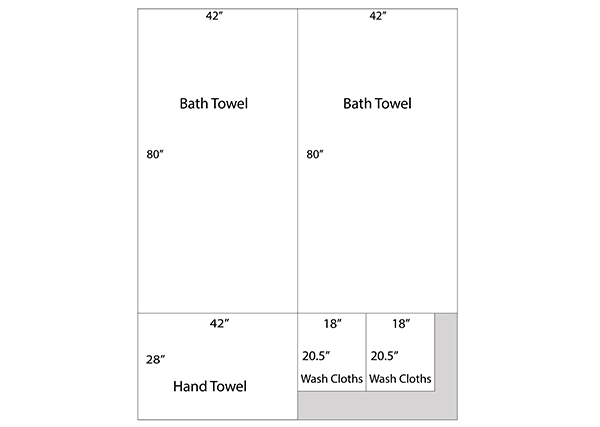
The diagram provides measurements for a full set of 5 towels that you can make out of just 3 yards of fabric! The towels come in three sizes: two bath towels, one hand towel, and two washcloths. Cut the fabric according to the cutting layout above.
You may find your pieces are really big, but keep in mind that the cloth will shrink once you pull the towels from the drier. It shrinks about 17% the weft of the fabric (width-wise) and 28% warp of the fabric (lengthwise). All of our towel measurements come over-sized to allow for shrinkage and include seam allowances.
Difficulty
Beginner
Sewing Time
1-2 hours
How to make a towel with hemmed edges
The basic double-fold hem is the most common finishing technique for all kinds of projects. It is simple to do and does not require many skills, making it suitable even for beginners. As the name indicates, a double-fold hem is made when you fold the fabric over on itself to the wrong side two times. We are going to show you how to achieve a clean machine stitched finish for your towels.
One of the first rules in sewing is to pre-wash your fabric before you cut it to ensure it doesn’t shrink. With the waffle weave fabric, however, we recommend working with unwashed fabric and only run it through the machine once you’ve finished sewing. It’s just so much easier to work with this fabric when it is still flat and crisp and not scrunched up after the wash and dry.
Materials
For a full set of 5 towels, you will need 3 yards of the IS010 Linen/Cotton Waffle Weave Toweling Fabric and a matching sewing thread.
Optional: Twill tape for the hanging loop.
Tools
Scissors, pins, ruler, chalk or fabric marker, measuring tape, sewing machine
Steps
1. Lay out your fabric and use the diagram provided in the pattern section of this tutorial to cut out your towels.
2. Cut off the selvedge.
3. Starting with the long sides, press the raw edges ¾” to the wrong side.
4. Press another ¾” and pin.
5. Stitch close to the inner folded edge to secure the folded edges.
6. Now press the short sides of your towels ¾” twice to the wrong side, then pin and edgestitch.
7. Lastly, throw your finished towels in the washer and drier and get ready for the surprise! The fabric will shrink after washing and form luxurious little honeycombs that are the hallmark of waffle weave.
Note: To wash your waffle weave towels, toss them in your washing machine with your regular mild detergent. Do not use fabric softener or bleach. Tumble dry on low.
Tip: If you would like to add a little hanging loop to your towels, just cut a small piece of twill tape (5” long), fold it in half and slip it under the folded hem. Pin and stitch to secure.
How to make a towel with bias bound edges
If you would like to take your sewing game up a notch, you could totally finish the edges of your towels with some bias tape. This technique is a great and slightly more sophisticated alternative to the basic double-fold hem and provides a clean and neat finish to your homemade towels. Plus, it’s a great way to add a pop of color simply by using contrasting bias tape.
Materials
For a full set of 5 towels you’ll need 3 yards of the IS010 Linen/Cotton Waffle Weave Toweling Fabric, 1 yard of our regular medium weight linen (pictured here is IL019 BLEACHED FS Signature Finish 100% linen) for the bias tape. You may use matching or contrasting color depending on the look you are trying to achieve.
Matching sewing thread.
Tools
Scissors, pins, ruler, chalk or fabric marker, 1” bias tape maker, measuring tape, sewing machine
Steps
To bind our towels, we recommend using regular medium weight linen. It will reduce bulk and create a nice clean finish.
1. To start, make long strips of bias tape. We have a great step-by-step tutorial that explains how to make your own bias tape and join the strips together.
2. Insert one end of the strip into the wide end of the tape maker and press the fabric down as you gently pull it through.
3. Unfold your bias tape and pin one of its raw edges to one straight edge of your towel aligning the two right sides together. Start in the middle of one side and fold the bias tape down into a triangle like this:
4. Stitch your bias tape to the fabric in the upper crease until you come to about seam-allowance distance away from the corner of your project (3/8″ in our example) and backstitch.
5. Fold your bias tape triangle up and to the right forming a 90 degree angle. Neatly finger press.
6. Then fold your tape around the other edge and pin again.
7. Starting exactly at the end of the previous seam, stitch your bias tape to the fabric in the upper crease until you come to about seam-allowance distance away from the second corner. Backstitch at the beginning and end of the seam.
8. Repeat steps 5-7 for the remaining corners until you reach the other end of the tape.
9. When you get back to your starting point, overlap 1 inch the two tails and stitch over joining them together. Remember to backstitch.
10. Trim the seam allowances and lightly press the tape away from the towel.
11. Carefully fold the tape over the stitching (to the wrong side of your fabric) taking care to cover the stitching as you fold. At the corners, check that it is folded into a nice diagonal. Pin.
12. Topstitch the tape in place (from the right side) in the crease or as close to the bottom edge as you feel comfortable. Remove the pins as you go.
13. Lastly, machine wash and dry your towels.
Our waffle towels are so soft and fluffy that will instantly become a part of your morning shower or evening bath rituals!





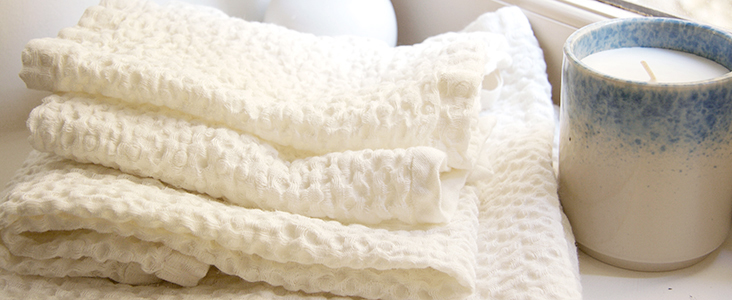
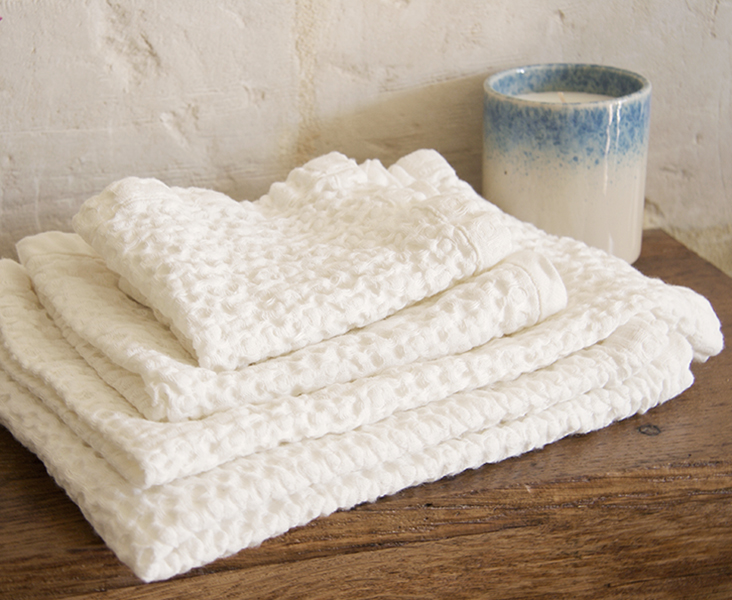
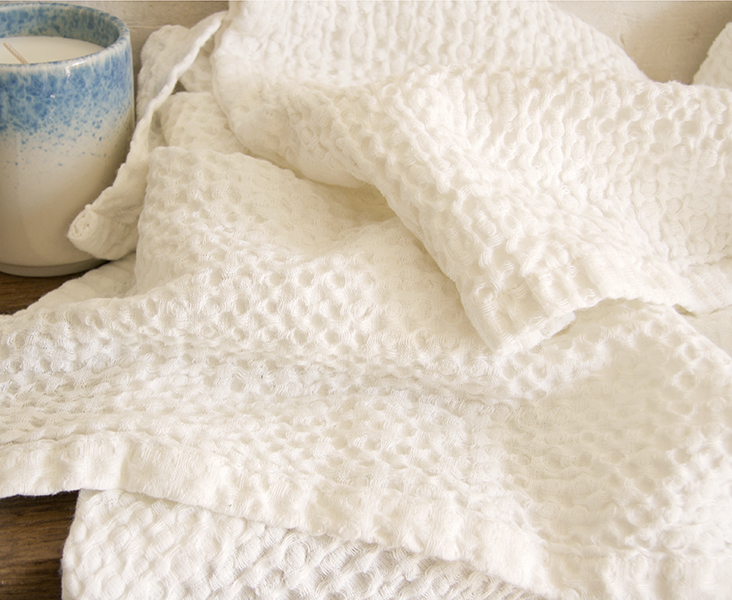
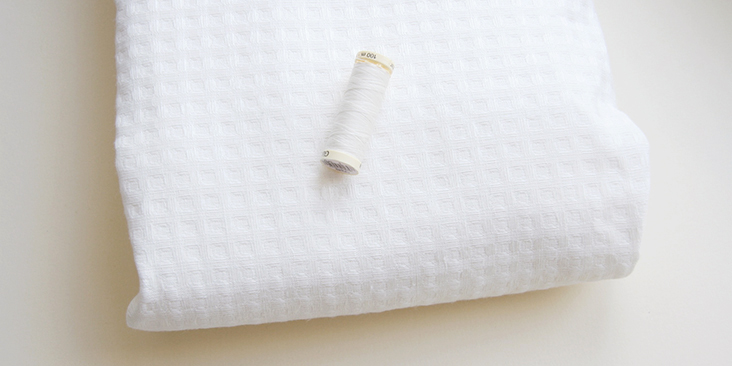
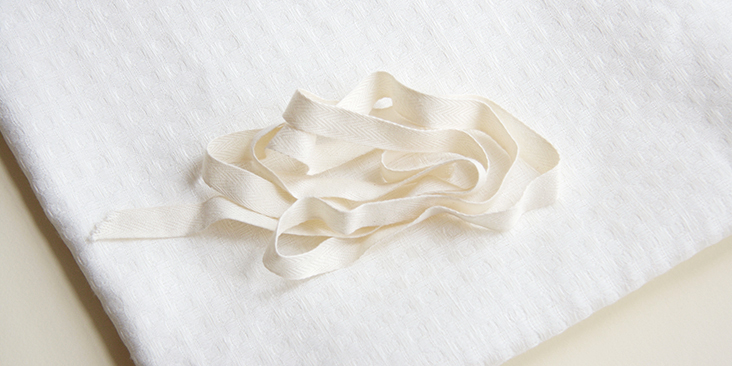
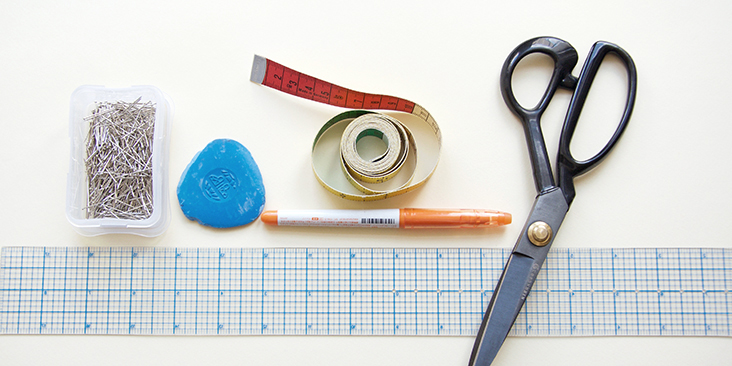
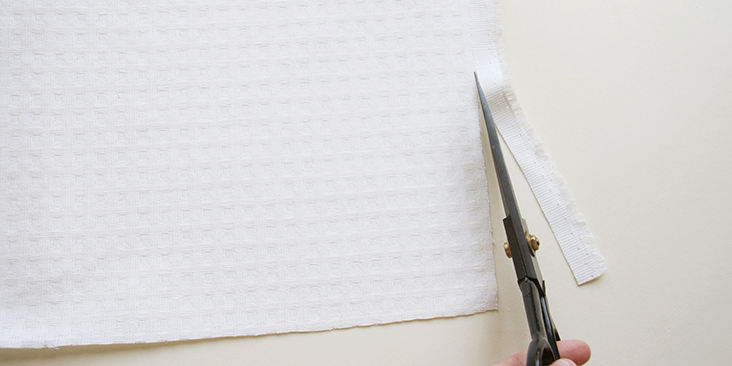
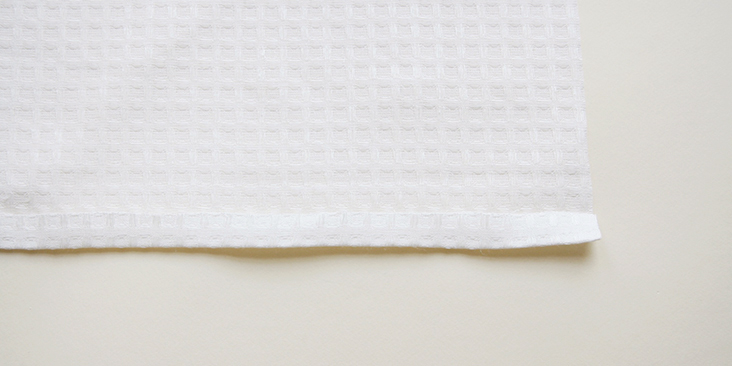
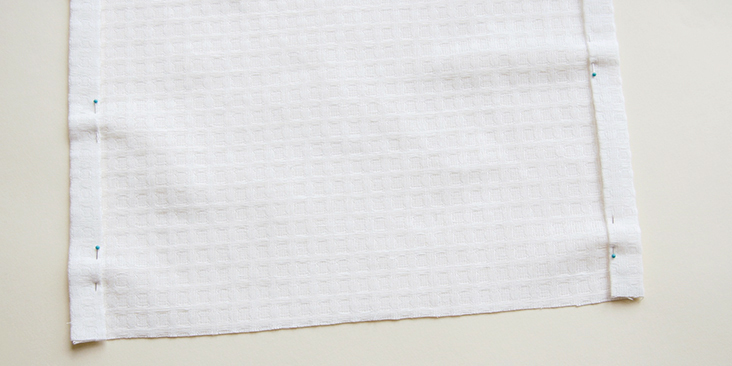
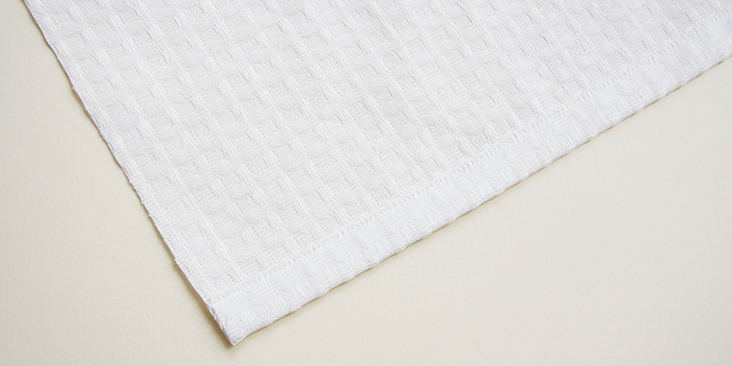
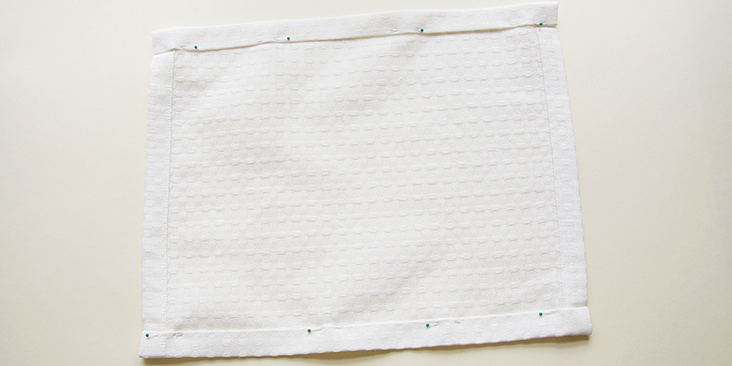
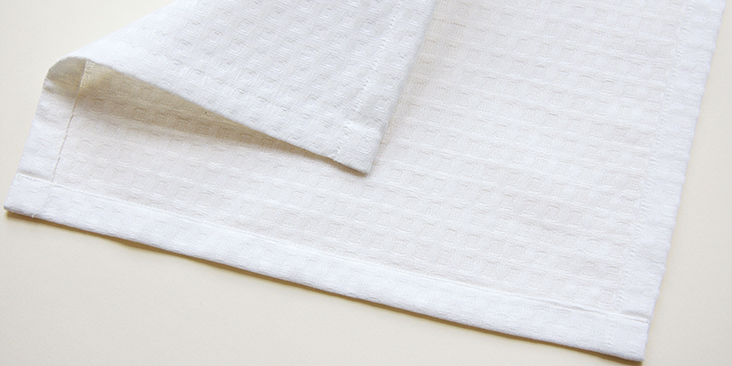
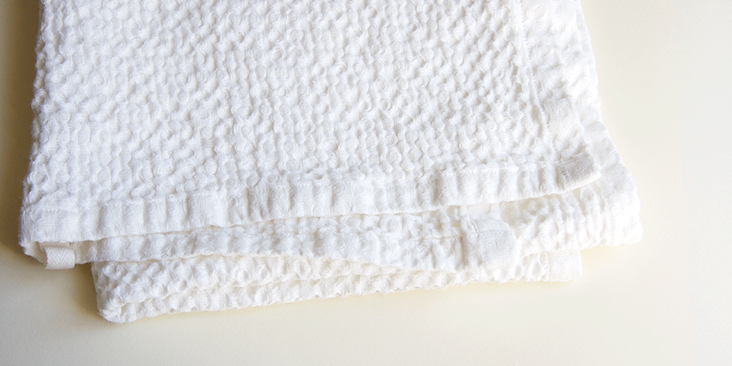
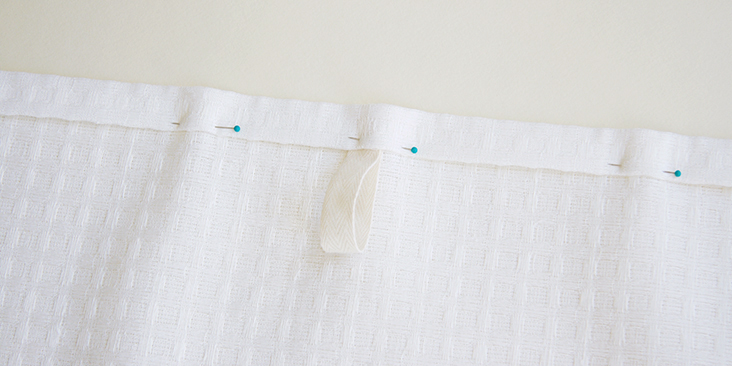
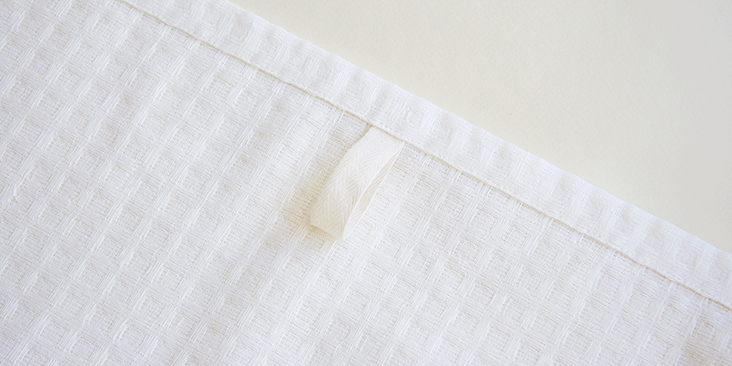
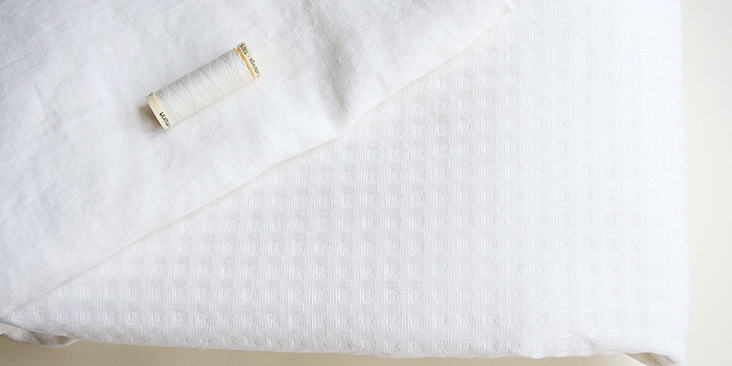
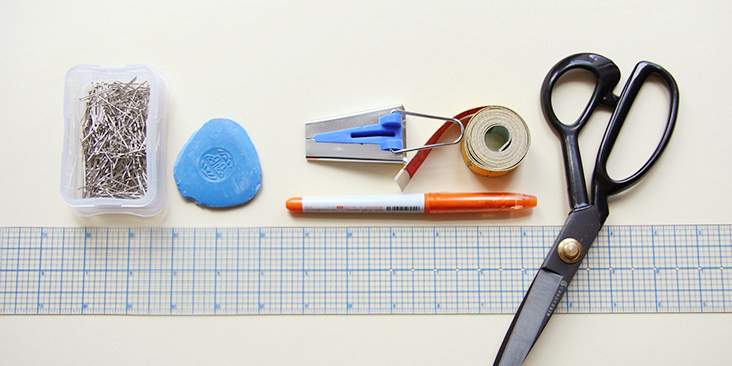
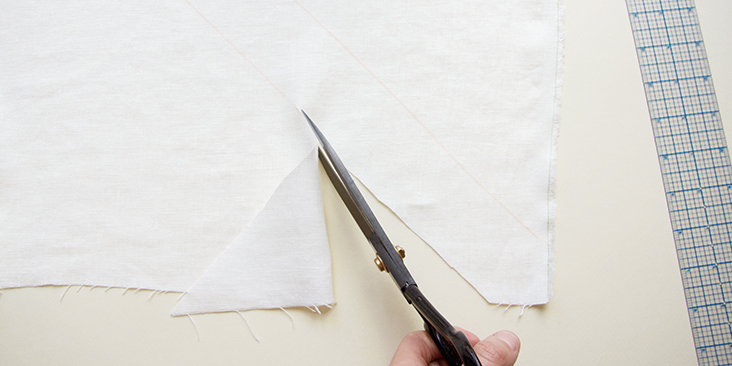
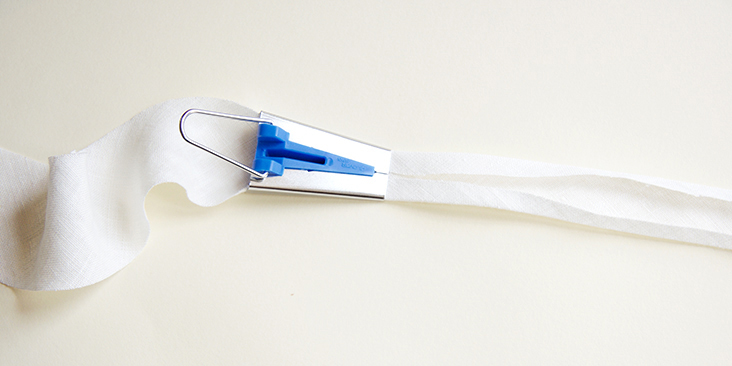
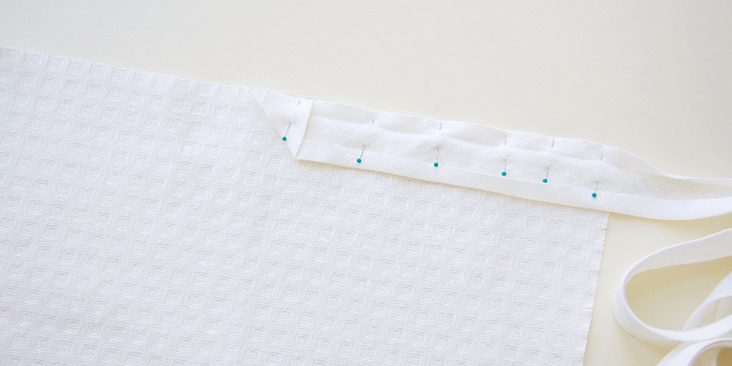
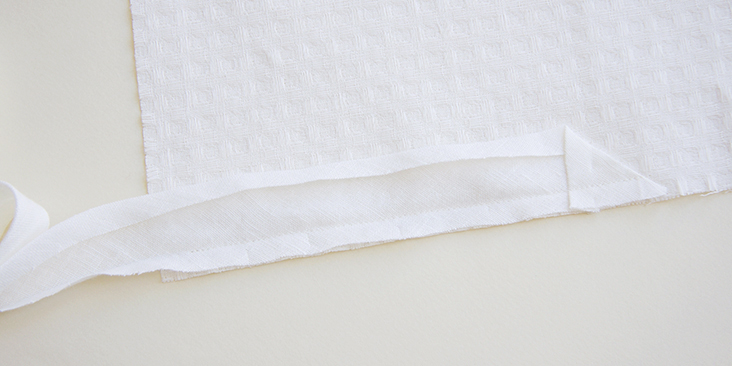
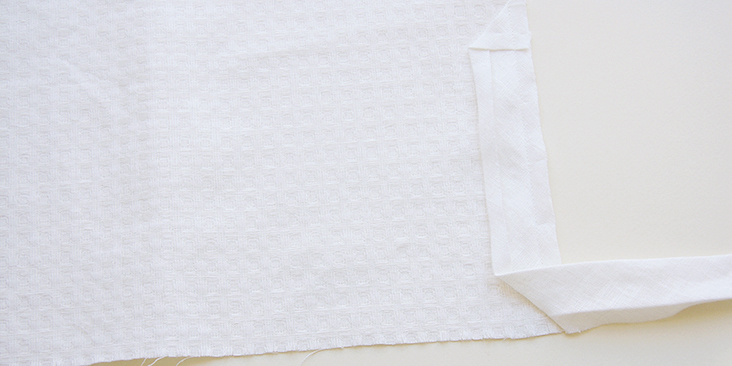
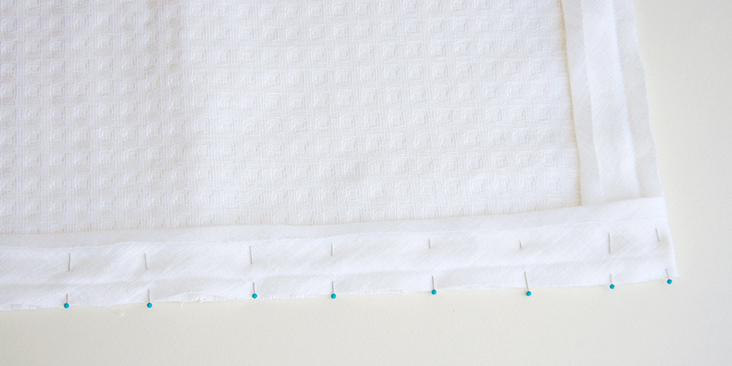
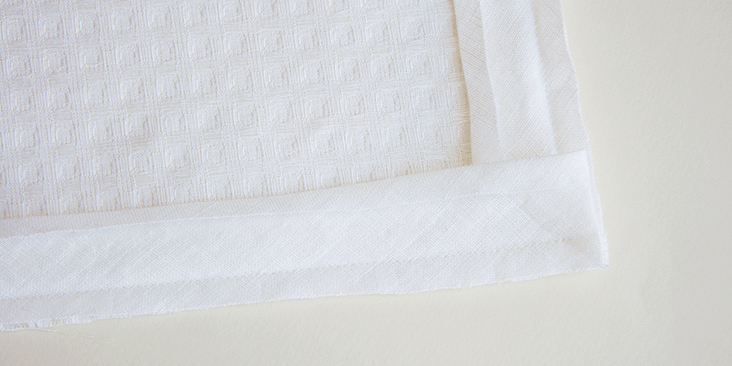
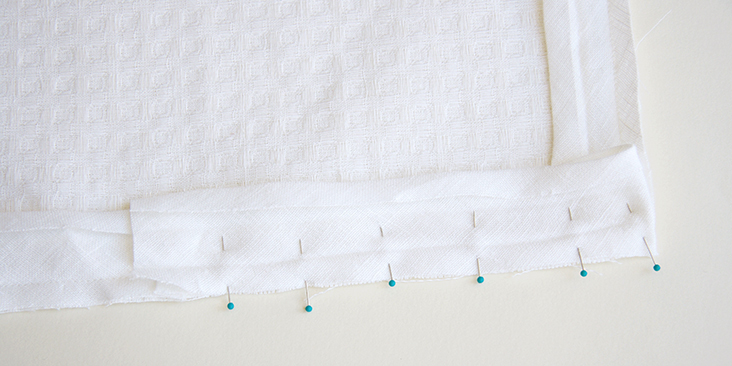
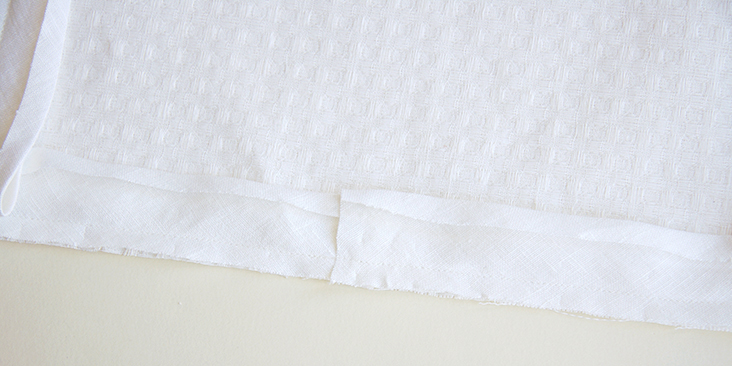
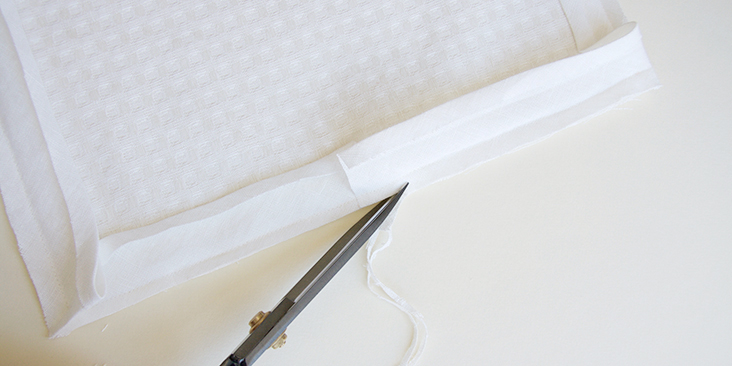
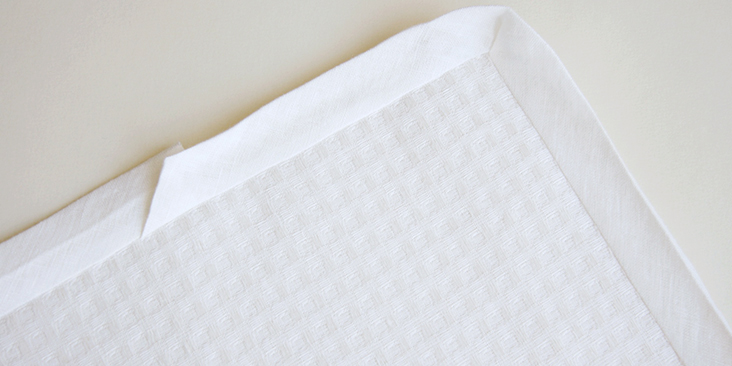
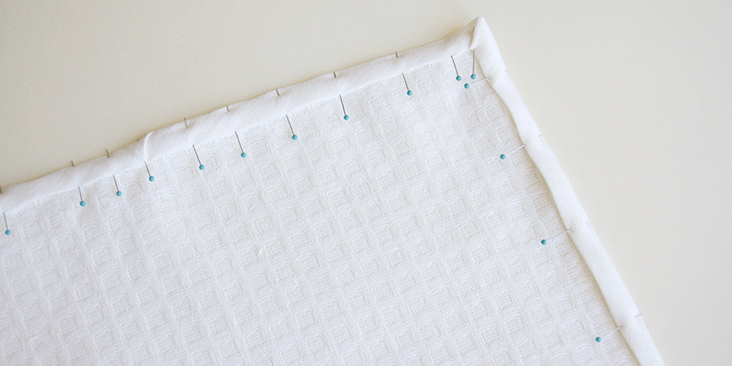
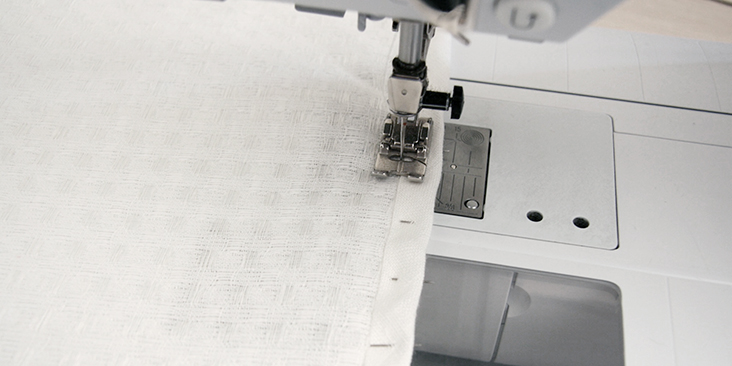
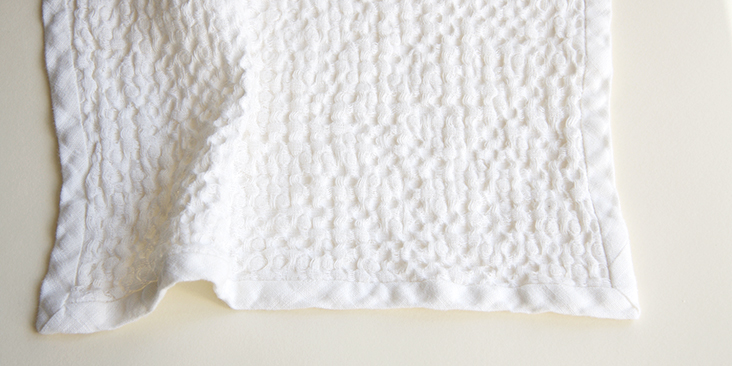
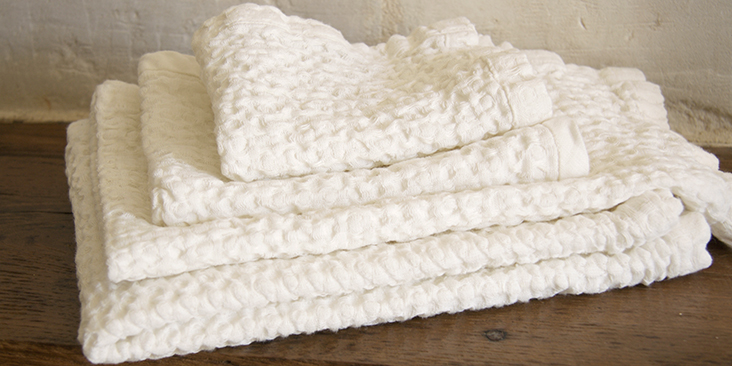
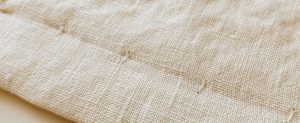
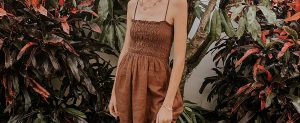
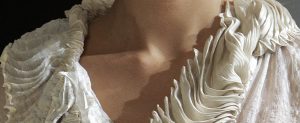
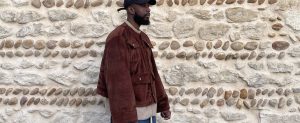
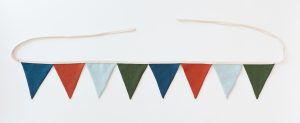







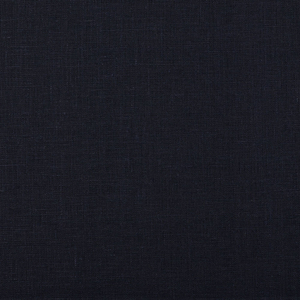

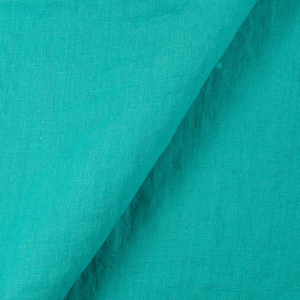

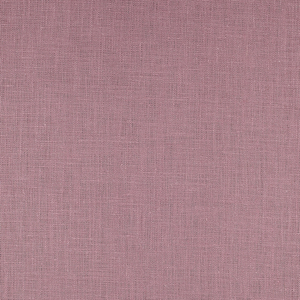

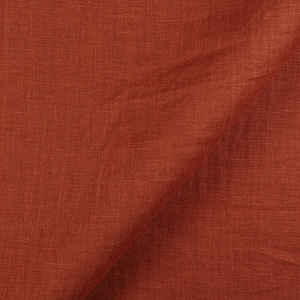

















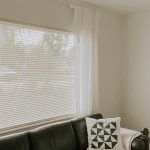
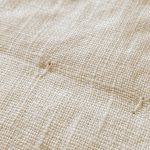


88 Comments
Jessica Baker
I have made two of these towels and love them. My husband would like one that is thicker and big. What could I do to make it a double layer without the bulk of the fold over seams?
Ruth Balster
Oh Jessica – I have been thinking I want to try that same thing. I thought perhaps about cutting the two pieces and then doing a few rows of stitching to make big blocks to hold the pieces together; and I am thinking of making doing the binding edge method as that wouldn’t be too thick and would also stabilize the two pieces together. My husband loves the towels single layer, and so do I, especially for summer, but I am thinking a double layer would be really nice as well!
Amy Pezzimenti
Do I need to use bias tape to finish edges or can it be cut wof? There are no curves so wondered if that would work.
Heidi Ruffalo
I’m surprised no one has mentioned how rough the towels turn out. They dry really well they just feel like a loofah. Is it just me?
Amanda Davidson
I personally don’t like them. My husband LOVES them. I’m thinking of making a robe for him. I’m going to try the linen softener, the fabric soap they sell, idk. Personal preference, I guess…
jo milam
Hi! Love these towels and wash cloths. Instead of trimming the selvage first, i measured and cut into the sections needed for towels and washcloths. Then trimmed the selvage. The first time i made these towels, i totally got lost which way was the side or which was the vertical and came up with an odd sized hand towel which was ok. So to limit my confusion, trimmed after cutting and no problem. Perfect!
G. Nelson
One question I don’t see is: is there a right and wrong side to this fabric???? I’ve already cut one hand towel, I’m going for it! But please do let me know if there’s a right and wrong side! Thanks!!!
Amanda Davidson
If you are making towels, not really. But if you want to make a robe there is definitely a WS and RS.
Trudy Young
Does anyone know where I can get measurements for a hooded baby towel ?
Daniele Duhamel
I have finally pulled the trigger for making some of these towels and purchased the fabric. As I like big towels, is the 80 x 42 size the correct size for a bath sheet?
Suzanne Bowes
Just a suggestion…use a contrasting thread color in your demonstration pics. It would be easier to see.
Thanks!
Mia SchoberKing
What are the dimensions for a (temporary) turban to wrap one’s wet hair with?
Lauren Linen
I made mine 40″ x 30″
jo milam
Thank you! i was just wondering that too.
Eleanor Segal
What size do I cut the fabric to get a 30” x 54” towel?
Eleanor Segal
I plan to do the fold over edges
Lauren Linen
You can cut your fabric according to the dimensions above provided for the ‘bath towel’ which are 42″ wide and 80″ long. This will yeild a towel approximately 32″ x 55″ when it has been seamed and washed.
Eleanor Segal
I cut my fabric before reading you response., 39 (weft) x 72 (warp).. I did the fold over edges as directed. Then washed it in warm water ( the rinse was cold). They came out of the dryer nicely, with finished dimensions 32x 60. Maybe the variation is with the washing machines and water temp???
Also I thought I read that 42’ wide 80” long yielded 35” x 70” finished …. So confusing… but glad I finally made and am happy with my towels… Next i will make 2 hand towels and 2 face cloths with the remaining 44” of fabric.
Lauren Linen
Hello Eleanor,
Yes, variations in washers and temperatures can have an impact of shrinkage rates. Another big impact is the amount of water used when washing your fabric. Water-saving and high efficiency machines can use less water than is needed to really shrink fabric. So you may like to wash your towels again to help give the fabric more time in water to shrink, and if possible for your machine, use a setting which uses a higher water level.
If anyone has felt their towels didn’t shrink as much as we estimated, the waffle texture hasn’t quite fluffed up in some areas, or shrinks more on subsequent washes water level, as well as washer type and temperature all have a part to play. We recommend a warm gentle wash with lots of water in the tub to fully submerge the fabric and a ‘low’ dryer setting if machine drying. If line drying, the weight of the waffle weave fabric can also stretch out under its ‘wet weight’ so you may find your fabric larger too.
Eleanor Segal
Thank you Lauren!
I finished my towels .
Mia SchoberKing
Yesterday, I made a 32×55-inch towel from a 42×72-inch piece. Folded 0.75-inch seam twice and stitched close to edge. Hope that helps
Mary Simmons
I am getting ready to cut my towels; how do I make sure that I am cutting straight across the bottom and top? Should I follow a line of the weave? My original order/cut of the fabric seems to be about 3″ off from one side to the other and I feel I need to even out the top edge before cutting the pattern or my towels will be wonky. Does that make sense? For regular linen, I usually pull a thread to ensure I have it straight, will that work with this waffle weave?
Lauren Linen
Hello, you can follow the line in the pattern of the waffle weave fabric to ensure you are cutting straight 🙂
Ginger Capers
May I please ask with regard to the linen bias binding…I purchased the waffle material & the medium weight linen in the same color. It’s recommended to sew the towels BEFORE washing/drying the waffle weave, but how about the plain linen (not signature finish)? Will the shrinkage be similar enough to sew the whole project pre-washing? Or should I wash the plain linen for the bias binding trim first? Thanks so much!!
GC
Lauren Linen
In this tutorial, Rima didn’t prewash any of the fabrics. If you are using our linen without the Signature Finish you may like to prewash it first.
Toni Fenton
Do you recommend mitered corners for folded edges on these towels?
Lauren Linen
Hello Toni, you can sew wither, it just comes down to personal preference
Sharon Barnett
Would this work well with an embroidered design? If not, what material do you suggest.
Lauren Linen
One of our customers have used this fabric for an embroidered design, They washed thier fabric first to pre-shrink it, then pressed the waffle down in the area they wanted to embroider.
Michelle Croft
I made a set and embroidered a floral pattern on the bath and hand towels after I washed and dried them. They turned out beautifully!
Marilyn Bowman
I purchased enoughIyardage to make 2 complete sets: bath, hand and washcloth. Followed directions exactly, using the double fold hem method. NOT HAPPY. The finished product looks sloppy and home made. The edges are very wrinkled looking, do not smooth out flat when folded for storage. They also look sloppy hanging in the bathroom. Most of all, even after several washings the towels are scratchy and hard. Even though the waffle weave fluffed up some, these are NOT fluffy bath towels. Also they continue to shed a lot of lint in the dryer. I am very disappointed with this purchase. Should have spent my money in the store for new towels.
brandis gray
Hey the difference is that the waffle towels you can buy (such as Kontex towels) are woven to the finished width and although they are sewn at the top and bottom hems, the hem part is woven in a flat weave not the waffle weave for about 3″ at each end, so this hem will remain flat. This is done by a special loom and reflected in the proce of the towels. Hand made towels cut from a bigger piece of fabric simply cannot look the same when they are made differently, it is an unrealistic expectation. As to the softness, do a rinse with 1 cup vinegar and that will bring out a great deal of softness
Mary Bradley
I wash my towels/linen 3 times before using or giving them as gifts. Afterwards there is only a minimal amount of lint. That just comes with this type of fabric. As for the texture, I think linen towelling is a personal preference. Personally, I am sick of fluffy towels that feel good but don’t actually dry when you come out of the shower. I love the feel of this linen because it is very absorbant and almost like an exfoliant. I made a set of towels for my daughter for Christmas and she, who used to love only big fluffy towels, adores these and has decided this is her new favorite – all because of the absorbancy. Plus, we think the waffle is pretty all elegantly puffy and wrinkly… 🙂
Kim Grant
I am so glad I found this post. I am a new sewer. I bought some very fluffy, waffle fabric to make towels The fabric is very fluffy on both sides. I tried to sew but failed miserably. I think the feed dogs are not moving the fabric and my machine is sewing in place and jamming. I have a Singer HD6800C which I would think would be an ok machine to use with it. What stitch length and width should I use with this type of fabric and what type of presser foot? Should I use a stretch needle or certain weight thread? Any feedback you could give would be much appreciated. Thank you.
Lauren Linen
Hi Kim,
I’ve sent you an email, but here is some handy hints for others wondering the same:
If your fabric is getting caught on the feed dogs I would recommend placing a strip of paper or ‘tear away’ under where you are going to sew. This is going to provide a barrier between your fabric and the feed dogs, and after sewing you can simply tear it away from your seams and hems.
I like to use a straight stitch that is a little longer than I usually sew with on linen, something around 3mm or about 8 or 9 stitches per inch is ideal with the standard presser foot for straight stitching.
Ronda Umbel
I would like the diagram for bath sheets larger than just towels. What is the address that I need to email to get it?
Barbara Shoneck
I purchased three yards of this waffle fabric and made two large bath sheets. I absolutely LOVE this fabric!!!!!!! Best bath sheets I have ever had.
brandis gray
Kim if the feed dogs don’t move the fabric you need more pressure on the presser foot. There should be a way to adjust this- look in your machine instruction book for this. Don’t use a stretch stitch, only use that for knits. If you haven’t done so in the last few years, take your machine somewhere for a tune up. It’s usually less than 200 and your machine will come back to you oiled and adjusted, abd working beautifully.
Caroline Kosaka
What size would you cut the fabric (pre washed) to make a hair towel?
Lauren Linen
Hello Caroline,
I cut my washed fabric to 40″ x 30″ for hair towels.
Elizabeth Klassen
Will all linen fabric shrink to the same degree that this waffle fabric does? Thinking about using other linen fabric in 3 yards to see what I will get when following instructions above. Thanks! New to sewing with linen.
Lauren Linen
Hello Elizabeth,
Thanks for your comment and welcome to the world of Linen! We have a variety of linen fabrics, all with different weave types, so this means they will also shrink differently too.
We wrote a handy guide to shrinkage, which you can find in our Help Center here:
https://support.fabrics-store.com/hc/en-us/articles/4403190857485-Fabric-Shrinkage
We also have a tutorial for making linen bath towels in our heavyweight 4C22 linen. You can download the guide for free here:
https://fabrics-store.com/sewing-patterns/milos-linen-bath-towel-pattern
As always, for any questions about our linen, please feel free to email or call us.
Daniele Todaro
Love my new towels! We prefer a bath towels to a bath sheets, so in one yard, you can cut a bath towel of 63”w x 36” and a hand towel of 21w” x 36” and get one bath towel of 54” x 26” (roughly the size of a standard bath towel) and a hand towel of 16”” x 26”. I also use one yard to cut 4 hand towels. I purchased 6 yards from which we got 4 bath towels and 12 hand towels, since we go through those frquently. Perfect.
Eleanor Segal
Was that cut the same direction as in the tutorial pattern?
Suzie Said
Question: I bought different colours of IS010 Cotton/Linen Waffle fabric.
can I sew the 2 or 3 colours together and make a multi colours beach towel.
What will happen to the line between the two fabrics when washed and dried?
Lauren Linen
HI Suzie, I’ve found if you join them together with a open flat felled seam, the join will be nearly impossible to see on the right side.
Sharon Barnett
What is an open flat felled seam?
Lauren Linen
We have a tutorial for this style of seam finish in our Help Center article. It is listed at number 5.
https://support.fabrics-store.com/hc/en-us/articles/360060749692-7-ways-to-finish-your-seams-when-working-with-Linen
Nanette Logue
I have some towels from the 1960s that I’ve hoarded (they still look good!) because they are a different size. They are in smaller today’s bath towels and larger than today’s hand towels. Now, I can make my own!
Karen Walters
Yikes! I must have made a mistake. I made linen double biased tape and sewed around two towels before washing the fabric. I was hoping to end up with towels the size that I like, 26″W x 47″L. I cut two pieces each 31″W x 60″L (17% to the width and 28% to the length, making sure that my width was lined up with the weft (selvedge edge). They washed up beautifully, however, they now measure 17″W x 50″L. What did I miss?
KW
Sacha Chevalier
How…you lost 9 inches in the width and gained 2 inches in length??? Are they still a rectangular shape with perpendicular sides, or is it more like a lopsided sideways diamond now? My only guess is if you didn’t pre wash the bias binding fabric it could have pulled the whole shape out of whack but I can’t imagine it would have done it by THAT much. Yikes! Lol don’t worry, we have all made a few sewing mistakes that are so bizarre we can’t even figure out how we did it. I spent half my weekend sewing and unpicking a reversible hood for a jacket I’m making…I did it wrong so many times I lost count.
Lauren Gates
Hello KW,
Our shrinkage rates are based on a warm water, gentle wash, and machine drying on a low setting. The waffle fabric will have some stretch after laundering which may also account for the added length since it will lengthen under its own weight.
Nancy Pinckley
I figure KW lost 14” in width and 10” in length! Now it’s a scarf for a child. I would want bath towels to be washed in hot water. These stories keep me from jumping all the way into linen everything.
brandis gray
1. You might actually have the warp and the weft mixed up. The warp runs the same direction as the selvage, the weft is perpendicular to the selvage.
2. To use the bias tape I would wash everything first, before any cutting, because the fabrics have different rates of shrinkage. When sewing the tape on, measure and mark the corners and use lots of pins so that you dont accidentally stretch the waffle part when you sew on the tape.
3. The only way to explain lengthening after wash9ng is that you mismeasured the length when you cut the waffle fabric
rhonda aardsma
How wide is the fabric?
Lauren Linen
84″ wide prior to washing
Anita Tigert
I have been wanting to try these towels for some time. I have seen retail towels somewhat like these for $100 for one bath sheet. I have used these retail towels before and been disappointed in how they absorb. Can I say how much I LOVE THESE TOWELS. They absorb so well and dry so fast! They were a dream to make. I am going to buy more fabric to make more towels. My old towels from the store will now become “dog” towels! Thank you so much for carrying this fabric.
Vicki Pickelman
I just received all my lovely fabric!! I would like to make a throw and put a fringe on one side. I tried to fringe the cut side and it’s taken me hours to just get 1 1/2 inch fringe. I am wondering if the selvage side would be just as difficult to fringe? ?? Of course there’s always the possibility of my not doing it exactly correct.… Any suggestions? Thank you, Vicki
Lauren Gates
Hello Vicki, If you’re pulling threads from your fabric to create a fringe, I’m sure you’re doing it correctly 🙂 The fabric can be harder to fringe after it has been washed, as the fibers have now bloomed and ‘fluffed up’. It will definitely take some time to pull threads away to create a fringe. I say grab yourself a nice drink and pop on your favorite TV show while you do it.
Sacha Chevalier
I would probably fold my fabric in half selvedge to selvedge, mark how long I want the fringe, then use mt rolling cutter to slash vertically up to the mark I made every, say…half inch? After that throw it in the wash to make the edges curl/fray. You may want to put a line of stitching right above the fringe line in a matching thread to keep the fringe from tearing. That’s just my thoughts.
Nanette Logue
ONLY GUESSING because I haven’t ordered this fabric YET, but based on the way it “blooms” after washing, the fringe might “ball up.” As Sacha (above) recommends, putting a line of stitching above sounds like a good idea. Maybe even sew a piece of plain weave linen to the edge and fringe that, instead of this textured fabric.
Molly Fleming
Binding the towels question. Both the waffle weave linen and the binding linen are not washed prior to sewing?
Lauren Gates
That’s correct Molly 🙂
Susan m Steinruck
What size would you cut the unwashed fabric to make a baby blanket?
Lauren Gates
Hello Susan,
This will depend on the finished size baby blanket you would like to make. What I would do is add the shrinkage of the fabric to your desired dimensions, plus seam allowance to figure out how much fabric you will need.
Approximate shrinkage – the width of cloth shrinks 17% (weft of the fabric) and 28% on the length ( warp of the fabric)
Nan Drozdowski
Please explain weft and warp for me. Thank you!
Lauren Linen
Hello,
The Warp of the fabric refers to the threads which lay parallel to the selvedge of the fabric. The selvedges are the bound finished sizes on the width of the fabric. So you can imagine the warp as the length of your fabric.
The weft is the threads which run across the width of your fabric 🙂
Danuta Snyder
I ordered only enough waffle weave fabric for one set of towels at first since I wanted to see how they’d turn out. LOVE THEM. I just ordered fabric for a second set. It’s subjective, but I don’t like plush towels. I want something that stimulates the skin. Don’t find this fabric rough, just invigorating. Maybe I’m a slow sewist, but I spent more than 1-2 hours. Mitering 28 corners took a long time. And I hard a hard time falling asleep because I was still mentally mitering! (Thanks to the person who mentioned following It’s Sew Easy’s mitering tutorial on Youtube…don’t find her comment here any longer though.) I am crazy about these towels!
Steve Tracewell
What was the finished size of the bath sheet after washing?
Lauren Gates
Hello Steve, I’ve popped the approximate finished towel measurements for you below, and for others wondering, I’ve also included the washcloth and hand towel dimensions as well.
Bath Sheet: 35″ x 70″
Hand Towel: 20 x 30″
Wash Cloths: 13″ x 13″ square.
Shauna Woloszyn
Please explain how unwashed 42″ x 84″ bath sheet finished size equals 35″ x 70″. Per shrinkage info online: 42″ width (weft 17%) = 34.86″ and 84″ length (warp 28%) = 60.86″. Of course none of this allows for loss of selvages or hemming. It would appear the 70″ figure above was also multiplied by the weft 17% shrinkage measurement. Retired accountant here, just trying to gauge my current towel measurements by any info on your site for hemmed and washed dimensions.
Lauren Linen
Hello Shauna,
This tutorial used to have measurements for bath sheets instead of bath towels as seen now. So the starting measurements were different that 42″ x 84″ and were laid on the fabric on the other direction. Keep using the shrinkage you listed to figure out your expected shrinkage.
Shauna Woloszyn
Thank you Lauren! That makes sense and I am using the shrinkage percentages for a different layout to achieve TWO hand towels! 🙂
Sue Corless
These towels look lovely. Can you tell me how much fabric is needed ti make the bias tape for one set of towels?
CJ Pope
I’m wondering the same thing. Maybe @Lauren Gates will weigh in with her expertise.
Heidi Dubose
I don’t like really large bath towels, so I was thinking about making 2 towels from 2 yards of fabric and having 1/2” fringed edges. I’m hoping for a towel that’s apx. 30” by 52” after shrinking…? Has anyone done this? Does my math seem right?
Lauren Gates
hello Heidi,
If you’re going to use 2 yards of fabric for 2 bath towels, you could cut 2 x ~36″x 84″(width of fabric). If the width of cloth shrinks 17% (weft of the fabric) and 28% on the length ( warp of the fabric), your finished towels will come out to approximately 25″x 69″ including the fringe.
If you cut your towels in the other direction, 42″ x 72″ they will shrink to approximately 34″x 51″, again, including fringe.
Jitka West
I also don’t like overly large towels and downsized my first set of these linen towels. However, this fabric is not thick like terry towels. Consequently, you will want more surface area to absorb the moisture from your skin. I now make them full size. LOL! I also recommend you fold over no less than one inch around the edges. A wider seam allowance doesn’t reduce the size of your towels much and it looks MUCH better. It is also easier to turn and press.
FYI – I’ll also be adding a bias tape to bind the edges on my next set. I think the extra work of creating and applying the bias tape won’t be much more than folding and pressing all those seams on the towels. Can’t wait to see how they turn out!
Nancy Lucas
Using 3 yards of fabric, this layout would leave 14.5 inches unused fabric-wouldn’t it make sense to increase the towel size?
Lauren Gates
You can do that if you’d prefer Nancy 🙂
Ann Kossakowski
I have not serged the edges, but have made several sets with fringed edges by simply stitching around the towels about 1/2 inch from each edge to prevent keep the fringe at about 1/2. They are lovely and so easy to do!!
Denise Ringer
Hi, has anyone tried serging the edges? Thanks
Virginia Duppenthaler
Per usual I wash all fabrics upon receiving them after serging the cut cut edge to prevent fraying. Now I see you hem the towels first. Now what do I do with waffle material? Looks too much like chenille and the wrong size for a bedspread. Please advise on other usage.
Lauren Gates
Hello Virginia, our customers have also used this fabric for a couch throw blanket, Bath robes, and baby blankets!
Rachel Pickering
I bought some of this fabric to make bathrobes. Normally I wash and dry before cutting pattern pieces, but you advise not doing it in this bath towel tutorial. Do you also not advise prewashing when using it for bathrobes?
Lauren Gates
Hello Rachel,
The bath towels are a special project where we can add shrinkage easily to a rectangular/sqaure shape, and if the shrinkage is off by a little, it’s okay, because it’s just towels, not a garment that will need to fit accurately.
For this reason, we recommend pre-washing your waffle fabric for garments to achieve the correct fit and size.
Joyce Schoonover
How wide is the bias tape to go around the towels. That looks super nice. Can’t wait to make some
Rima Khusainova
Hi Joyce! For a 1″ bias tape maker you’ll need to cut a strip of fabric on the bias that is 2″ wide. Once pressed and folded in half, you’ll get a finished width of 1/2″ -wide bias tape.